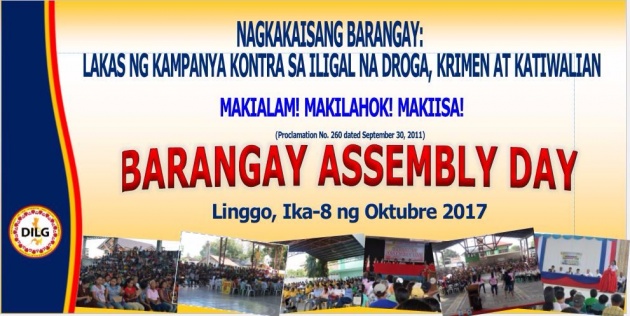Image Credits: DILG.gov.ph
Barangay or village is the smallest administrative or the basic political unit of government in the Philippines. Every barangay is supervised by the “Punong Barangay” or Head of the Village. The Punong Barangay, with the help of the Barangay Council, is responsible for the general welfare of the whole community within his/her jurisdiction.
The Punong Barangay, being the Chief Executive of the barangay exercises three kinds of power such as Executive Power, Judicial Power, and Police Power (Section 389 of the Local Government Code 0f 1991). So, as far as the exercise of governmental power is concerned, we can say that the Punong Barangay is the most powerful because he or she has been given the power over the three areas of the government.
In every barangay, there is a set of officers that forms part of the entire barangay administration. Aside from the Punong Barangay, there is the council which composes of 7 members. There are additional officials such as the Barangay treasurer and the secretary. The Punong Barangay and the council were all elected while the treasurer and the secretary were appointed by the Punong Barangay.
How Many Barangays Do We Have in the Philippines?
The Philippines has a total of 42, 036 barangays all over the country. The largest barangay is Bagong Silang or Barangay 176 in Caloocan City, Metro Manila. The Barangay has a total land area of 524.68 hectares and with 245,000 residents which comprise of about 16% of the total population of Caloocan City.
While Bagong Silang is the largest barangay, the Philippine National Census of 2007 identified Barangay 630, Sampaloc District Metro Manila as the smallest barangay having only 33 residents as of 2007.
Significant Characteristics of the Barangays
Barangay is the main administrative unit concern when it comes to delivery of the basic services to the people. Barangay has been given explicit autonomy by the Local Government Code of 1991 wherein they are granted the full authority to plan and establish their own future with minimum intervention from the national government. Barangay is given the power to enact ordinances for the general welfare of the constituents as well as tax and revenue ordinance subject to the limitations of the law.
Image Credits: DILG Philippines via Twitter
The Barangay Assembly
The Barangay Assembly is the highest decision-making body in the barangay. Looking at this chart, we can say that the Barangay Assembly has the authority over the whole barangay and the barangay officials including the Punong Barangay is under the power of the Barangay Assembly.

Image Credits: 1bp.blogspot.com
Barangay assembly is composed of all persons who are actual residents of the Barangay for at least six (6) months, fifteen(15) years of age or over, citizens of the Philippines, and duly registered in the list of Barangay assembly members. (Source: Section 397 of the Local Government Code).
Why We Need to Attend the Barangay Assembly Meeting

Image Credits: DILG Philippines
As a resident of the barangay and as a member of the highest policy-making body in our respective villages, we are required by law to attend and participate in the General Assembly Meeting which is to be conducted at least twice a year.
The Barangay assembly shall meet at least twice a year to hear and discuss the
semestral report of the Sangguniang Barangay concerning its activities and finances as
well as problems affecting the Barangay. Its meetings shall be held upon call of the
Punong Barangay or of at least four (4) members of the Sangguniang Barangay, or upon
written petition of at least five percent (5%) of the assembly members.
Source: Paragraph (b) Section 397 of the Local Government Code of 1991

Image Credits: DILG Philippines
For this year, 2017, The Barangay assembly Meeting was scheduled on March 25, 2017, for the first semester and October 8, 2017, for the second semester. Memorandum Circular No. 2017-123 was already released by the Department of the Interior and Local Government on September 20, 2017, setting October 8, 2017, as the date of the synchronized Barangay Assembly Meeting.
“Barangay officials who fail to conduct a barangay assembly may face corresponding administrative complaints be which can be filed by any resident of the barangay, concerned citizen, governmental or non-governmental entity before the Sangguniang Panlungsod or Sangguniang Bayan concerned,”
DILG Officer-in-Charge (OIC) Catalino S. Cuy
What Are the Things That Need to Be Presented

Image Credits: DILG Philippines Twitter
During the conduct of the Barangay Assembly Meeting, every barangay is enjoined to discuss the (1) State of the Barangay Address (SOBA), (2) Accomplishments for the first semester, (3) Financial Reports of the first semester including the utilization for the Sangguniang Kabataan Funds for Fiscal Year 2017 and (4) updates of the Calendar Year 2017 programs and projects.
Video Credits: Rupert Groggs via YouTube
Likewise, compliance with national laws should also be discussed, such as Barangay Full Disclosure, Anti-Illegal Drugs Laws and related issuances, Batas Kasambahay Law, and Expanded Anit-Trafficking in Persons Act of 2012.
Every barangay should also discuss issues affecting the barangay, such as but not limited to peace and order, disaster preparedness and solid waste management.
All of these should be presented to the meeting including the Message of the Secretary of the Interior and Local Government, copy of which shall be made available to the concerned barangays or villages.
Let Our Voice Be Heard
The program should not end without the opinions, suggestions and other concerns from the community are heard. An open forum should form part of the program. In fact, an open forum is the most important portion which we should not forget.
Oftentimes, residents of the barangays do not give time to this activity because they were not well informed of its importance. Some people would consider attending to general assembly meeting as a waste of time.
There are some residents who are complaining about the services being given by the barangay officials in their respective villages but they lack the courage to open the issue during this activity.
As a member of the Barangay Assembly, please be it known that we are the highest authority in the barangay. So, we have the right to know. Let your voice be heard, let us attend, participate and take this opportunity to know what is happening in our community especially in our country.
This is for our own benefit.
Here is a video of the first semester Barangay Assembly for 2017.
Video Credits: rhap ocampo via YouTube
*****
References:
Philippine Statistics Authority
Memorandum Circular No. 2017-123
Written for Bitlanders
by Sharon Lopez
Thank you for reading.
Please visit my blog for more articles. Have a great day my friends!
Sharon Lopez is a graduate of Bachelor of Science in Commerce Major in Banking and Finance and currently working in the government handling programs on Business Friendly and Competetive LGUs.
You may visit me on Facebook.
*******************************************************************************************************************************
Disclaimer: The views and opinions expressed in this blog post are that of the author and does not in any way represent the agency or department she currently belongs.





